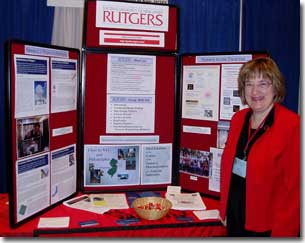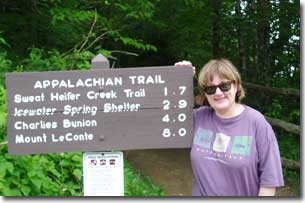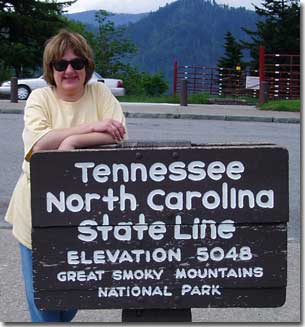Jolie Cizewski
Though her parents never earned high school degrees, Jolie Cizewski became a nuclear physicist. She “caught the research bug,” as she puts it, after working in a nuclear physics lab during the summer while she was in college, and has been working in nuclear physics ever since.

Recruiting graduate students at annual meeting of the Societies of Black & Hispanic physicists.
Cizewski grew up in Maryland. Her parents didn’t have high school diplomas. Her father earned a GED, and her mother, a refugee from Czechoslovakia, attended a high school that closed during World War II before she would have received a diploma. But they valued education, and always pushed their children to excel.
As a child, Cizewski dreamed of becoming an astronomer. But when she was growing up in the 1960s, girls weren’t expected to go into science. She remembers having been the only girl allowed to join the science club in 6 th grade. “That sense that a woman couldn’t do science was something that I felt from my family, from my teachers, sometimes from my friends. That was the norm in that period.”
But with her parents’ support, Cizewski did well academically, and went to college at the University of Pennsylvania. During her freshman year, she met her first role model, Fay Ajzenberg-Selove, a successful nuclear physicist and the first woman chair of the American Physical Society’s Division of Nuclear Physics. “Fay Ajzenberg-Selove was an example of a woman who was very strong, very supportive, and was a very good scientist at the same time. I continue a friendship with her to this day,” says Cizewski.
Eager to dive into research, rather than spend the summer at home in her small town, Cizewski asked for a summer job and was sent to work in H. Terry Fortune’s lab. She spent the summer after her sophomore year doing experimental nuclear physics research. “I caught the research bug that summer,” she says.
She has been working in the field of nuclear physics ever since. “I like nuclear physics because these are complex systems, but you can understand them with relatively simple models,” she says.

Dr. Cizewski hiking along the Appalachian trail in Tennessee.
Cizewski is now a professor at Rutgers University in New Jersey. Some of her research has involved studying the shapes of nuclei. Some atomic nuclei have specific numbers of neutrons and/or protons that make them very stable. Those numbers are sometimes called “magic numbers.” When you look at nuclei that don’t have these magic numbers, the nuclei often take on interesting shapes, such as pancakes or footballs. Working with Rick Casten at Brookhaven National Lab Cizewski helped to find an interesting new shape, which, she says, “you can think of as being tri-axial, but only if you take a kind of time-averaged snapshot of it. It’s very soft. It’s constantly changing shape between prolate and oblate.”
More recently, she has been studying nuclei far from stability, heavy nuclei with many more neutrons than a stable isotope. These nuclei may be involved in an astrophysical process, says Cizewski. “In a sense my research has come full circle. I’m doing work that is important for nuclear astrophysics. My original love was astronomy.”
The astrophysical process, called the r-process, for “rapid neutron capture process” is believed to occur in supernovas and is responsible for the synthesis of about half of the elements heavier than iron. Nuclear models need to be reconciled with data on the abundances of elements in the cosmos, and Cizewski’s measurements, which she does using beams of rare isotopes at the Holifield Radioactive Ion Beam Facility at Oak Ridge National Laboratory in Tennessee, could help point the way to new understanding. “What really excites me is to understand something that no one’s ever understood before,” she says. “For over 50 years we’ve adopted a shell model of atomic structure. The cosmos is telling us that breaks down. I’m starting to do the first measurements that could be telling us how that model that we’ve been using for 50 years breaks down.”
In addition to her research, Cizewski serves as vice dean of the graduate school, which has nearly 4000 graduate students in all disciplines. She also works to make research opportunities available to students who might not otherwise have such opportunities, including minority students and students from backgrounds like her own.

Dr. Cizewski in the Smokies along the Tennessee and North Carolina border.
She also mentors her own group of graduate students, and is very proud of the dozen or so students she’s advised over the years. Though she and her husband don’t have children of their own, she says, “I feel like my graduate students are my children. So I haven’t missed out on nurturing younger people.”
Cizewski’s students have gone on to a wide variety of careers. One of her former students has become a professor in Turkey. The rest have gone on to careers at national labs, in both basic and applied science, and in a variety of industries, including telecommunications and computer-related industries. “People think of PhDs as being clones of their professors, and I really feel that the PhD can be so much more than just being a clone of me,” says Cizewski.
Training in experimental nuclear physics prepares students well for these diverse careers, she says. Because they conduct research in fairly small teams, the students learn to work in a group, but they also take on leadership roles because each student has his or her own project. To complete their research, they have to learn not only nuclear physics, but also electronics, computer programming, and data analysis, says Cizewski. “You really have to be engaged in all parts of the effort. You learn everything.”











